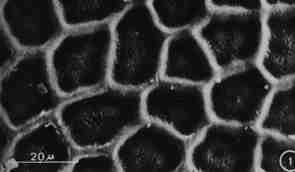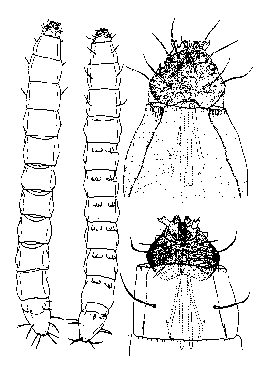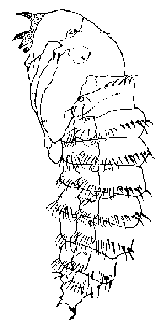|

Andrenosoma atra (Linné, 1758): Polygon structure of the surface of the egg [Musso 1978]
|
WOOD (1981): "Shape subsherical (Leptogaster spp., Dioctria spp.) to long oval, more than three times as long as wide (Efferia spp.); but shape in most species semioval, two to two and one-half times as long as wide. Length 0,29-2.2 mm; width 0.25-0.72 mm. Chorion smooth, without ornamentations in most genera (six genera viewed with scanning electron microscope, 2000x, Dennis and Lavigne 1975), or with characteristic elevated ridges (Cerotainia Scarbrough 1978) (some European species of Dioctria and Laphria Meigen, Melin 1923). Color usually creamy white, varying to orange, amber, or brownish. Description based on eggs of 22 species in 12 genera from North America and three species of Dioctria from Europe (Melin 1923, Knutson 1972, Dennis and Lavigne 1975, Scarbrough 1978)."
MUSSO (1981): "The comparative study [by scanning electron microscope] of eggs in Asilidae reveals at least 3 different types: (a) pigmented eggs with a thick chorion of irregular polygon suface structure, (b) unpigmented eggs with a thick chorion covered by tubercles and cevices, or with a thin chorion without such peculiar structure, (c) eggs covered with a thin pellicle of sand grains. Type (a) was observed only in members of the subfamilia Laphriinae, type (b) in several species of the subfamilia Asilinae, and type (c) only in Antipalus varipes (Meigen, 1820) of the same subfamilia. Type (c) correlating with a special conformation of the female genitalia, is unique in Asilidae, but common in Bombyliidae."

Machimus rusticus (Meigen, 1820): External aspect of a new-born larva [Musso 1978]
|
WOOD (1981): "Elongate, subcylindrical to somewhat dorsoventrally fattened, often tapering at each end. Color white to yellowish, sometimes with a few fine longitudinal streaks. Four instars in the few forms studied. Head capsule much narrower than prothorax, usually exerted, directed ventrally. Nine abdominal segments apparently present, with eighth and ninth partly fused; length of segments increasing towards seventh. Respiratory system functionally amphispneustic, although vestigal spiracles are present on first seven abdominal segements. Head capsule much narrower than prothorax, usually exerted, directed ventrally. Respiratory system functionally amphipneustic, although vestigial spiracles are present on first seven abdominal segments. Head capsule with light to dark brown sclerotized cranium bearing one to three pairs of bristles laterally and medially. Antenna small to minute, arising from anterolateral corner of head capsule. Mandible narrow, heavily sclerotized, lying in concavity in median face of maxilla, not extending to apex of maxilla, strongly reduced or lacking in Leptogastrinae. Labrum slender, wedge-like. ..."
MUSSO (1981): "Comparative studies on the planidial L1 of various species show quite a homogeneity as to their cephalic skeleton, absence of labrum, small mandibulae, simplified labium, devoid of a filter apparatus, and reduction of salivary glands relating to special ecological requirements and peculiar trophic behavior. The L2 and L3 are morphologically rather alike and differ from L1 according to their habits of living."

Tolmerus atricapillus (Fallén, 1814): Pupa inlateral aspect [Hull 1962]
|
WOOD (1981) (In: Majer 1997): "Mobile, have free sheaths for the mouth parts. Coloration from white at formation, darkening to yellow, brown, or dark brown; processes darker, brownish or reddish brown. Horn shaped antennal sheath with several stout pointed spines called antennal processes; one pair of large sharply pointed anterior antennal processes arising on vertex, directed anteriorly and somewhat curved ventrally (blunt or truncate and ridged in Leptogastrinae); one group of three to five posterior antennalprocesses present, acuminate or subacuminate apically, with confluent bases (absent or reduced to a crenulate ridge in Leptogastrinae). Lower facial area with one or two pairs of short spine-like processes in Laphriinae, absent in other subfamilies. Mouthpart sheaths well-developed; labral, maxillary, and hypopharyngeal sheaths smooth or with rugose areas, often with small tubercles distally. Anterior margin of thorax with oval anterior spiracle. Leg sheaths visible, hind leg sheath extending to middle of abdominal segment 3. A pair of anterior mesothoracic spines present laterally above base of midleg sheath, posterior mesothoracic spine usually present on callosity at base of wing sheath; only one or two bristles in Leptogaster, Dioctria, and Heteropogon Loew; one or two pairs of small bristles may present on dorsum of thorax. Abdomen nine segmented, mostly flexed ventrally, but eighth and ninth partly united; segments except the ninth with a lateral spiracle. Anterior margin of abdominal tergite 1 with transverse row of 6-16 long spines. Tergites 2-7 with median transverse row of spines. Sternites 2-7 usually with posterior transverse row of bristles; sometimes this row incomplete or absent. Pleurites 2-7 each with transverse row of elongate spines or bristles arising dorsolaterally; number varying from 1 to 14, absent in Heteropogon and Stenopogon, usually fewer than five in Dasypogoninae, usually five or more in other subfamilies. Abdominal segment 8 with encircling ring of long spines, often with fewer spines than in previous segments. Abdominal segment 9 with one to four pairs of strongly sclerotized terminal caudal hooks; the dorsolateral pair of hooks always present, occasionally toothed or branched (Lasiopogon Loew, Leptogaster); the ventrolateral pair present in all subfamilies except Leptogastrinae; smaller ventromedial processes present in Laphriinae, Asilinae, and a few Dasypogoninae, but absent in most Dasypogoninae, and Leptogastrinae; one or two pairs of tubercles may present, spine-like or rounded, size varying with sex."
|